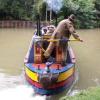Do you mean a truly genuine continuous 4mph?
If so on what canal, and how deep at the point you are trying?
4mph is a maximum speed on most canals, but not all narrow boats can achieve it, and many will come nowhere close if the canal is narrow and shallow.
On a practical note hand held tachometers are relatively easy to come by at low cost. You could use one of these to double check the RPM the engine is at, (by measuring rotation of the crankshaft pulley), then also that that the prop-shaft is rotating at.
Then if (say) you have a 2:1 reduction on your gearbox, (it will be marked on it usually), but the prop-shaft is not achieving 1000 RPM, when the engine is doing 2000 RPM, you know that the box must be "slipping" in some way, and this could well be exacerbating the problem.
However if you establish that the speed the prop-shaft is rotating at is correct for the engine speed and the actual stated reduction ratio of your box, then I'm rather struggling to see why replacing the box is expected to cure the problem.
Others with more experience may wish to comment on that logic, though!
FWIW, the boat we recently sold, (50 foot) that had a BMC 1800 engine and a PRM box wsith a 2:1 reduction probably needed to be at over 1,500 RPM to genuinely make 4 MPH on a deepish canal, (so prop at 750 RPM). If it was shallow, then winding it up to that or above would have been counter productive, but I doubt even if run the engine at 2000 RPM for quite a while that the coolant temperature would ever have risen much above that that the thermostat opened at (82 degrees in our case).



